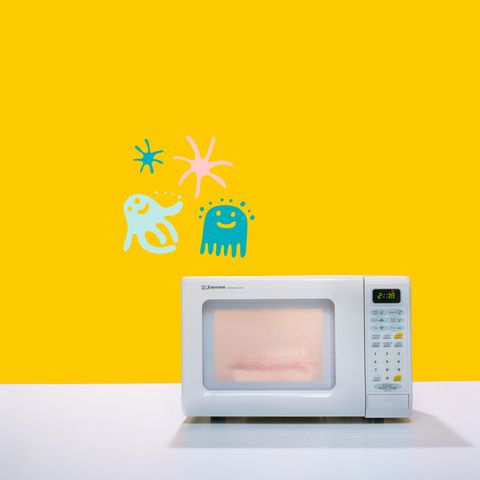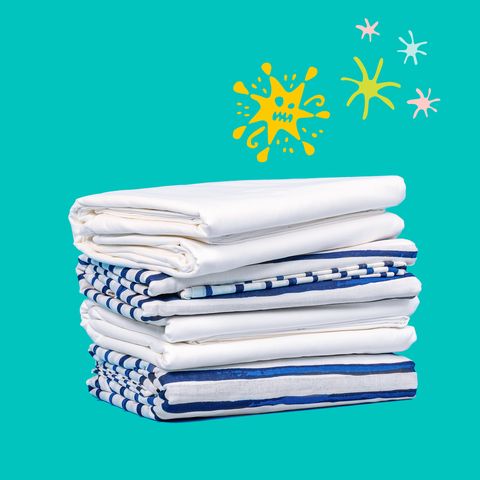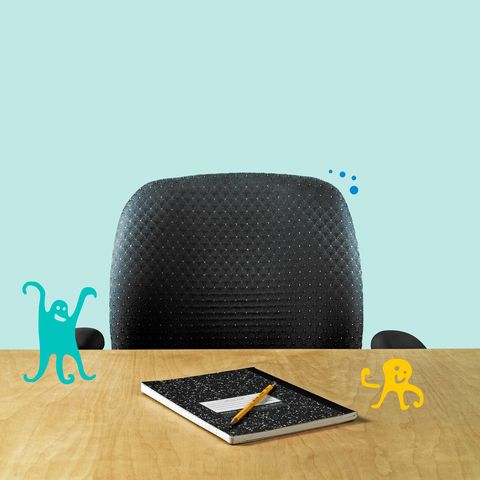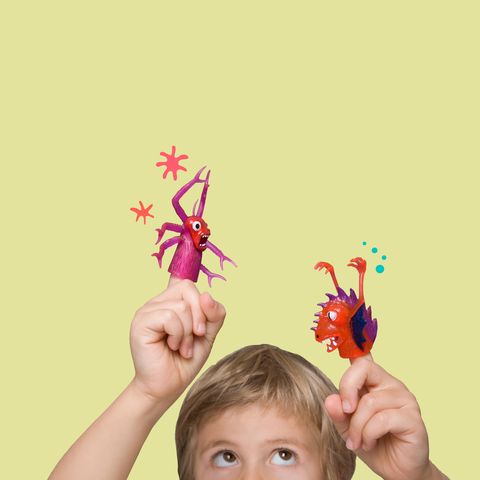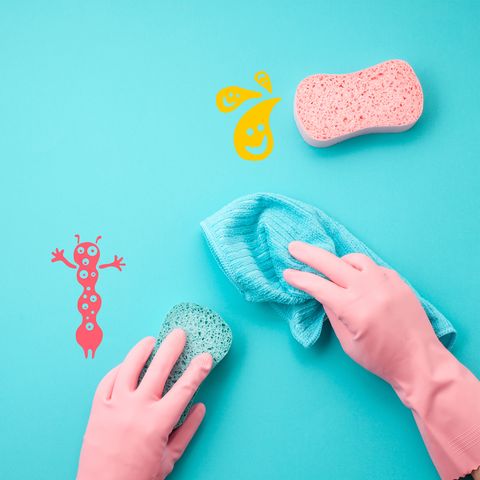If all the talk of a “twindemic”—the overlap between COVID-19 and flu season—has sent you into a cleaning frenzy, you’re not alone. But it takes more than a simple paper-towel swipe of the counters and doorknobs to clean and truly disinfect.
First things first: You need a quality product — ideally one that’s overtly labeled as a disinfectant, like 3M TB Quat Disinfectant Ready-to-Use Cleaner. If you’re not sure, check the U.S. Environmental Protection Agency (EPA) registration number on the label, says Carolyn Forte, Cleaning Lab Director at the Good Housekeeping Institute. Then, type that number into the agency’s database for specifics on what type of bacteria and viruses against which it’s effective.
Proper usage is also extremely important. It’s a common misconception that you can simply spritz and wipe. The truth: Proper disinfecting takes time. Check the product directions for how long hard, non-porous surfaces must stay wet for the most effective germ killing, says Forte. When cleaning a surface with 3M TB Quat Disinfectant Ready-to-Use Cleaner, for example, a hard non-porous surface needs to remain wet with the cleaning solution and untouched for one minute in order to kill the virus that causes COVID-19 (**SARS-Related Coronavirus 2). But even the most quality cleaners won’t do much good if you don’t know what areas to target.
To help you protect your home — and its occupants! — we asked a cleaning expert where germs congregate, then how to tackle these important spots.
1Hit High Touch Surfaces
You definitely want to target often-touched places, like countertops and doorknobs, but here’s an important area that might get overlooked: appliance handles. The refrigerator, dishwasher, oven door handles, microwave touchpad, coffeemaker, and stove knobs also need frequent disinfecting, says Forte.
To clean, use a scrub sponge and soapy water to wipe away any grease or grime from the handles, then wipe down with fresh water and dry. Finally, use disinfectant spray to bust bacteria and virus germs.
2Clean Your Towels Regularly
If you hang your bathroom towels on a towel bar and let them dry well after each use, they can be used about three times before you toss them in the laundry. But hand towels are another story, says Forte. Hand towels soil faster, so they need to be changed daily (at most, every two days), depending on usage. And if someone in your house is sick, towels should not be shared and should be laundered after each use.
To clean, toss white towels in a hot water cycle with regular bleach. Colored towels can typically handle color-safe bleach and stain remover, but check the label to be sure. For reinforcement against bacteria, add in a laundry sanitizer.
3Change Your Sheets More
While you’re tackling the laundry, add your sheets to the mix. Though sheets are heavily used, most people let this task fall by the wayside — despite the fact that experts recommend laundering them at least once a week (and even more frequently if someone is sick).
To quell germs and dust mites, send your sheets for a spin in a hot water cycle. And don’t forget about your pillows and duvet, which should be laundered at least twice per year.
To help these items dry more efficiently — it’s important to keep excess moisture at bay to prevent mold and mildew issues — uncouple any sheets, cases, and covers, then give each item a shake before adding them to the drum of the dryer. You can also add dryer balls (or even clean tennis balls!) to separate laundry and allow air to circulate in the dryer, ultimately speeding up drying time.
4Scour The Bathroom
You probably already know that your toilet is one of the dirtiest things in your home and, as such, should be cleaned weekly. The quickest way to tackle the job: Pour 1/3 cup bleach into the bowl, then brush it around the sides and under the rim, says Forte. Then, let it sit for five minutes while you move on to another task, like disinfecting the surfaces in the room. To finish the task, simply flush the bleach once the timer’s up.
If you leave the lid up when you flush, germy particles can spray up to six feet across the room, says Forte. (Yuck!) Don’t skip this part — even if your counters don’t look dirty. Use a disinfectant to banish germs, and consider instituting a new rule to help stop the spread: Lid down before you flush.
Finally, give your tub and shower some attention. These wet, warm places breed mildew and scum, but a weekly clean and disinfect can help these surfaces resist stains and bacteria. To make the task easier, run a squeegee over the surfaces after you wash up.
5Wipe Down Electronics
Wipe down your personal devices — laptops and cellphones, for example — but pay special attention to shared tech, like household remotes. They get passed from person to person and rarely get cleaned, if at all, says Forte.
To clean, unplug or remove any batteries (replace the cover), then dampen a cloth with a disinfectant. Go over the item with the cloth, paying special attention to spaces between keys or buttons. (A cotton swab can help you get into any of those narrow areas and grooves.) Wait a few minutes for the cleaning solution to begin to evaporate, then dry with a lint-free cloth and plug back in or reinstall batteries.
6Don’t Forget Your Desk
It’s not just the electronics on the desk that require disinfecting. Your desk itself is 100 times dirtier than the average toilet seat (!). To banish germs, hit this spot at least once per week. Remove any surface clutter and proceed as you would when cleaning your counters: Spritz with a disinfectant, let sit for the required amount of time indicated on the package and then wipe clean.
7Tackle The Kids’ Toys
Since kids have a tendency to get up close and personal with their beloved playthings, It’s important to thoroughly clean any washable items often. Always check the care label, as some delicate toys may only be safe to spot clean, but generally solid plastic toys are safe to put in the dishwasher. Make sure that hollow toys with holes in the bottom, especially bath toys, drain and dry completely — water or moisture left inside can promote the growth of mold.
To clean stuffed toys, place them in a pillowcase, knot the top, and, if safe, wash and dry them on a gentle, low-temperature cycle. If the toy is durable enough, steam or sanitizing cycles will provide a more thorough clean. You can also try steaming stuffed toys with a garment steamer, spraying them with a fabric-safe sanitizer or leaving the toys in direct sunlight for a few hours to let UV rays do the job for you.
8Scrub The Kitchen Sink
Just because you use it to clean dishes, doesn’t mean the kitchen sink is germ-free. In a study by NSF International, the kitchen sink had higher concentrations of bacteria than almost any other household item tested.
To sanitize this spot in a flash, first you need to clean it. Use a sponge and all-purpose cleaner to remove any dirt and grim, then rinse and dry it out. Then, use a disinfecting spray or wipe to re-wet the sink and faucet surfaces, keeping them wet for the required time on the label and letting them air dry.
9Do A Deep Dive On Carpets
That soft rug may feel nice underfoot, but all that traffic brings an alarming amount of bacteria — 4,000 times more bacteria than your toilet seat, to be exact. Vacuum carpets and rugs at least once a week, and for an extra punch, spray with a carpet-safe sanitizing product first. Alternatively, you can use a steam cleaner for a deep clean.
